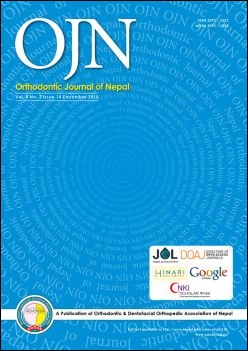TADs assisted Camouflage Orthodontic Treatment of Class II Division 1 Malocclusion in a Non Growing Patient: A case report
DOI:
https://doi.org/10.3126/ojn.v8i2.23073Keywords:
Anchorage loss, ClassIIdiv 1 malocclusion, Non growing patient, TADs (temporary anchorage devices)Abstract
Class II, Division I malocclusion has been described as the most frequent treatment problem in orthodontic practice. Aim & objectives of the present case report was to evaluate the management of skeletal Class II division 1 malocclusion in non growing patient with extraction of upper first premolars. Clinical and cephalometric evaluation revealed skeletal Class II with Angles Class II division 1 malocclusion with mild mandibular anterior crowding and increased overjet, severe maxillary incisor proclination, mild mandibular crowding, exaggerated curve of spee, convex profile, incompetent lips, increased overjet and overbite. Maxillary first premolars were extracted followed by en-masse retraction of anteriors with the help of temporary anchorage devices (TADs) to avoid anchorage loss. Mandibular incisor was extracted to correct curve of spee. Following treatment marked improvement in patient’s smile, facial profile and lip competence were achieved and there was a remarkable increase in the patient’s confidence and quality of life.
Downloads
Downloads
Published
How to Cite
Issue
Section
License
Copyright © held by Orthodontic & Dentofacial Orthopedic Association of Nepal
- Copyright on any research article is transferred in full to the Orthodontic & Dentofacial Orthopedic Association of Nepal upon publication in the journal. The copyright transfer includes the right to reproduce and distribute the article in any form of reproduction (printing, electronic media or any other form).
- Articles in the Orthodontic Journal of Nepal are Open Access articles published under the Creative Commons CC BY License (https://creativecommons.org/licenses/by/4.0/)
- This license permits use, distribution and reproduction in any medium, provided the original work is properly cited.




